EGYTPIAN
MUSEUM, CAIRO
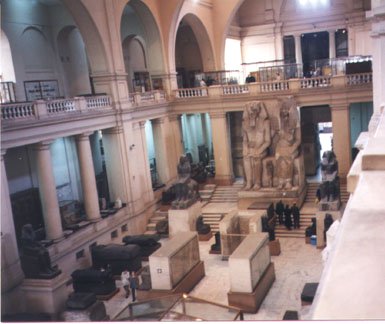
Everyone who is interested in ancient Egypt should make sure that they visit the
Egyptian Museum of Antiquities in Cairo. It was supposed to be half of a day on our
itinerary, with visits to "Old Cairo" (synagogues, mosques, Coptic churches, and
the big bazaar) for the rest of the day. However, we were only interested in ancient
Egypt, so we told the tour guides to give us a full day at the Cairo Museum instead. Even
so, there is so much to see there that we still didn't get to see it all. (Make sure to
pay the extra fee to see the room of pharonic mummies, as it is well worth the price to
gaze upon the actual preserved face and body of Ramesses II.) The view above is from
the second floor, looking down on one of the large museum rooms. The 23 foot high
limestone statue of Amenhotep III and his wife Queen Tiyi is at one end of the room,
giving scale to this photo.
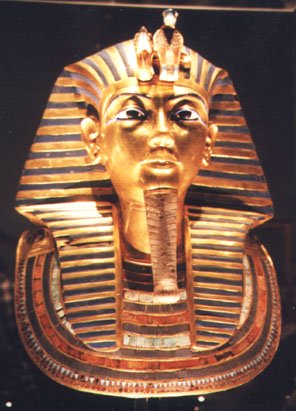
The most impressive and well known collection in the museum are the items taken
from the tomb of Tutankhamun ("King Tut"). The famous funerary mask is seen
above, in one of the few photos of that group that turned out relatively clearly (it was
hard to get proper focusing and work around the reflections with the glass cases that
surrounded the artifacts). Note the vulture head and neck to the left of the rearing cobra
(above the forehead).
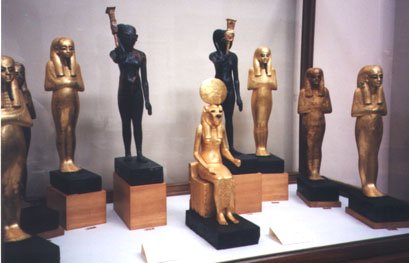
Some of the museum's best surviving examples of funerary items (treasures buried
with the pharaoh to go with him into the afterlife) come from the tomb of Tutankhamun.
Here is a very small portion, showing one case full of statuettes (some gilded) that are
about a foot tall. Note the seated statuette of Sehkmet (the lion-headed goddess), with
the sun symbol on her head.
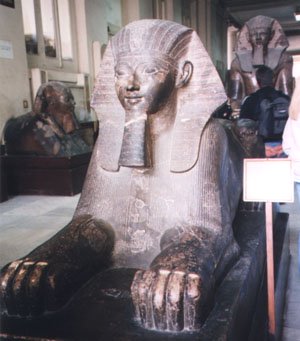
One of many stone sphinxes in the museum. It is several feet tall and 6 to 8 feet
long. Other statues can be seen in the background.
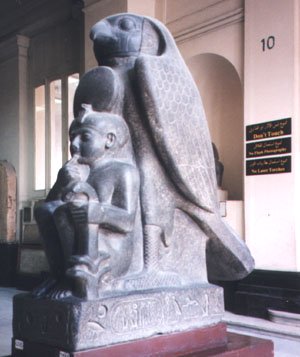
A large stone statue portraying a young pharaoh (youth is shown by having his
finger in his mouth), under the watchful protection of the falcon god Horus. The disk of
the sun is above the child's head.
We saw some other "sights" while we were in Cairo,
thanks to our tour company. We were taken to a papyrus shop (where you buy art prints of
ancient Egyptian motifs on papyrus paper), a carpet-making school (where you see how
carpets are made and then they try to get you to buy some finished examples), and a
perfume store (where they show you how Egyptian perfumes differ from those in the Western
world, then they try to sell some to you). I had the impression that the shops we
were taken to received some sort of kick-back from the tour company, or else the tour
guide got some sort of commission from the shops, or perhaps the shop owners were personal
friends of the guide. There were plenty of similar shops of each type that we passed by,
so obviously there was some reason to choose our particular examples. In any case, except
for one or two of the papyrus prints *, I wasn't interested in buying anything, and wished
we could have used the time to explore archeological sites instead. By the way, Sue found
the carpet-making demonstration to be upseting due to the way they used child labor, and
some of the kids seemed to be fearful that they weren't being quick enough during the
demonstration for the visiting tourists. Even I found it a little uncomfortable, but the
shop keeper said that they took in orphans from the streets, who otherwise would have died
without having that job.
* Click HERE to see some of the papyrus
art now in my collection.
One interesting thing that I remember about Cairo was seeing
modern roads and highways that contained an ever-changing mix of occupants. There were
modern cars, old buses, donkey carts, camels, bicyclists, and pedestrians all going the
same direction. It seemed like the slowest "vehicles" usually stayed to the
outside of the lanes, but at other times it looked very confused. We were told by our
guide that he who used his horn the most usually won the right of way.